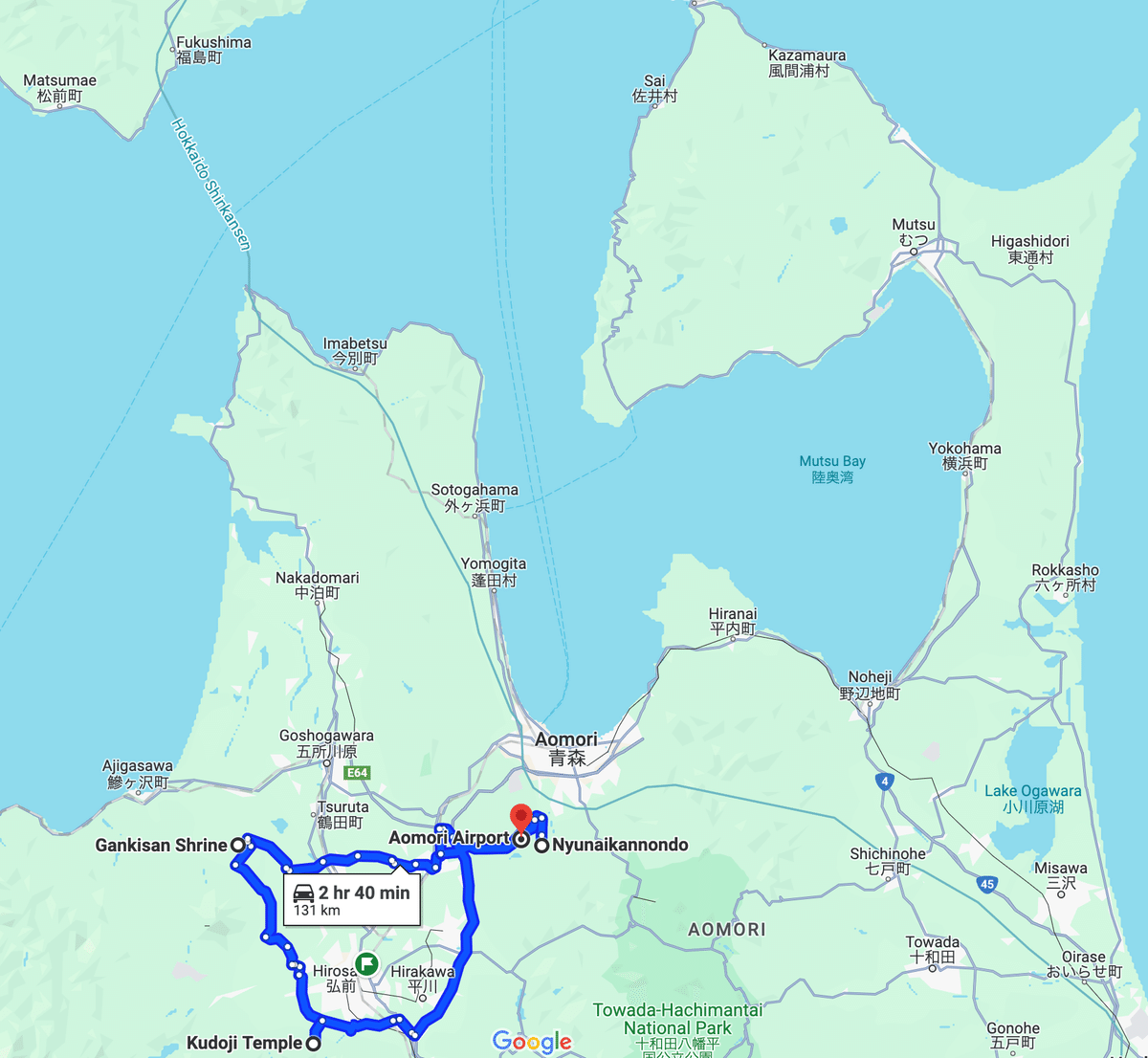
Tsugaru Spiritual Adventure: Journey to Make Your Wishes Come True by Visiting 3 Selected Temples and 2 Jomon Sites
Let me share my secret recommended 'shortcut route' for you to visit. These three selected temples and shrines, chosen from the 33 Tsugaru Kannon, are ideal when you're short on time but have a special wish you want to come true.
The Three Temples
1. Kudoji Temple:(1st Temple)
Kudoji is known as the head temple of "Oshira-sama", a godness that every Shaman or Itako in Aomori worships or showing great love and respect to a god. The origins of "Oshira-sama" are various, but it is said to be a hidden name for the goddess "Seoritsu-hime" ,a goddess of water who sits by the river and washes away all sins into the sea. "Seoritsu-hime" was said to beloved and worshipped by about 70% of Japan before the Meiji period. Seoritsu-hime is also regarded as a goddess of the Jomon period and of Lemuria.
There's a tradition to say "you are cute" to Oshira-sama. This is connected to a story from the Jomon period where people would say "you are cute" in various situations. It leads to curiosity: why did people in the Jomon Period often say 'you are cute' to each other?"

2. Gankisan Shrine : (5th Temple)
Gankisan Shrine is located at a place called Tokoshinai. It is said that the Jomon culture spread to Tokoshinai from the Sannai-Maruyama site. The Jomon culture existed in harmony with the changes in nature, and it is said that the move to Tokoshinai occurred during a period of cooling.
Gankisan Shrine was originally a branch temple of Iwakiyama Shrine, centered on spiritual mountain worship (nature worship). It represents the unique Japanese sensibility that perceives divinity in all aspects of nature, a spirituality that has persisted since ancient times.
While there is a theory that "oni" (demons) were considered evil, in the Tsugaru area, especially around Mount Iwaki, they were seen as benevolent beings. This belief stems from tales of a tall youth known as Ohito, who lived on Mount Iwaki and descended the mountain to help people, suggesting that these Ohito might have been part of the Ainu tribe, similar to the historical figure Aterui.

3. Nyunaikannondo: (24th Temple)
When one look up the sky and prayed, from within Nyunai, purple clouds descended, and from these clouds, a rain of arrows fell, vanquishing the demons. Nyunai Kannon Hall is a historic site mentioned in the old tales of Tsugaru and was considered the number one power spot in Japan where a monument stands, commemorating the official visit of Emperor Showa's brother. It is also a place where traveling monks continue to say, "Even if you cannot visit the other 32 Kannon temples in Tsugaru, make sure to visit here.
Originally, the pilgrimage of the 33 Kannon temples in Tsugaru began for memorial services. However, over time, more people started making the pilgrimage to fulfill various wishes, and today, there are endless stories of miracles, such as people being blessed with children they had given up on or recovering from illnesses after pilgrimage.
Nearby is the Komakino Site, famous for its Stonehenge-like structure. One aspect of Japan’s nature worship includes the reverence of megaliths (Iwakura rocks). Stones are an inseparable part of the Japanese faith, something not to be overlooked.

The two archaeological sites
It is recommended to visit the two sites after Nyunai Kannon Hall.
【Komakino Remains】
At the Komakino Remains, you can see a stone circle. In Japan, stones are a familiar presence, used to create gardens and worshiped as objects of faith. The Komakino Remains feature intentionally arranged triple concentric stone circles, with the central part believed to be arranged for rituals to gather energy. It’s hard to grasp at first glance, so it is recommended to visit with a guide.
【San'nai-Maruyama Remains】
The San'nai-Maruyama Special Historical Site is a large-scale Jomon period archaeological site discovered 1994. Records from the Edo period acknowledged its existence, but it was not considered significant. Construction for a planned prefectural baseball stadium unearthed continuous traces of ancient life, including pottery, leading to the halt of construction.
Previously, the site was a playground for children, where casual digging would yield many pieces of pottery, which were then used as toys or simply discarded. Recently, yeast dating back to the Jomon period has been discovered here and is now being utilized for food, further enhancing the site's allure.
【Routing Advice】
From Aomori Airport, a total route is about 150 kilometers. Shrines and temples are believed to have the clearest and most beautiful energy from sunrise to early morning, so experiencing this serene energy is highly recommended. In Japan, the time near sunset is known as "Ohmagatoki" or "Kawataredoki," a moment when various spiritual worlds intersect. Start early to visit three temples or shrines, and spend the last twilight time at the Jomon archaeological sites, where you might encounter the sky once seen by the Jomon people. (Note: Summer closing time around 17:00 is recommended to visit, spring and autumn between 16:00 to 17:00 to visit; winter can be challenging due to cold weather and heavy snow.)
【日本語訳】(出典: 津軽33観音めぐり)
奇跡に出逢う津軽33観音巡り、厳選3寺院+2つの縄文遺跡を巡る旅
【叶えたい願いを拝む厳選3つの寺院】
1番札所 久渡寺
5番札所 巌鬼山神社
24番札所 入内観音堂
33観音の中でも時間がないけどどうしても叶えたい願があるという時には
この3つを回りなさいという特にオススメのチートルートです
【久渡寺】(Kudoji Temple)
久渡寺は「おしらさま」という、青森のシャーマン・イタコが必ず祀る祭神の総本山
「おしらさま」は諸説ありますが、明治以前に日本全体の約7割が信仰し愛していたという「瀬織津姫」という神様の隠し名です。瀬織津姫は縄文の女神・レムリアの女神とも言われます。
おしらさまには「かわいいね」と声を掛けること、という約束があります。縄文時代何かあると「かわいいね」と声を掛け合っていたというお話と繋がり、縄文ミステリーが深まります
【巌鬼山神社】(Gankisan Shrine)
巌鬼山神社は三内丸山から縄文文化が派生したとされる「十腰内(とこしない)」という場所にあります。縄文文化は自然の変化とともに在り、十腰内への派生は寒冷化が起きた際に移動していったのではないかと言われています。
また、もともと岩木山(いわきやま)神社という霊山信仰(自然信仰)の中心であった寺院の末寺で、古来より続く森羅万象、全てのもの、自然にもすべて神が宿るという日本人ならではの感性、新興の在り方が感じられる場所です。
鬼は「悪い人」だったという説もありますが、津軽、特に岩木山付近における「鬼」は「優しい存在」であったとされています。岩木山に住むオオヒトと呼ばれる背の高い人間の青年が山を下りては人々を助けていたことに由来していますが、このオオヒトは阿弖流為(Aterui)の様な「アイノ(ヌ)族」だったのではないかとも考えられます。
【入内観音堂】(Nyunaikannondo)
「天に助けを求めると、入内の方から紫色の雲が舞い降りてきて、雲から矢の雨が降り鬼は退治された。」入内観音堂は津軽昔ばなしにもでてくる歴史ある場所で、昭和中期には日本一のパワースポットだとして昭和天皇の弟君が正式参拝された記念碑もあります。「津軽33観音、他の観音様を巡れなくてもここだけは拝んでおきなさい」と道行く行者が語り継ぐ場所でもあります。
元来、津軽33観音巡りは供養のために始まったとされます。が、いつの頃からか諸願成就のために巡る人が増え、現代においても、実際に「参拝後に、諦めていた子宝に恵まれた」「病気が治った」という奇跡の話が後を絶ちません。
すぐ近くにはストーンヘンジが有名な小牧野遺跡もあります!日本の自然信仰の 1 つに、巨石 (磐座) 信仰というものが存在します。 石は、日本人たちの信仰と切り離せない存在の1 つでもあり、見逃せません。
【小牧野遺跡】Komakino Remains
小牧野遺跡ではストーンサークルを見ることができます。
日本では石で庭園を創り上げたり石自体を信仰の対象としたりと石が身近な存在です。
小牧野遺跡では意図的に組まれた 3 重の環状列石を見ることができます。
特に中央部分はエネルギーが集まるように組まれたとされる祭祀用の組み方になっています。
一見しただけでは分かりづらいので、ガイドとともに訪れるのがおすすめ。
【三内丸山遺跡】 San'nai-Maruyama Special Historical Site
1994 年頃に発見された大規模な縄文遺跡。江戸時代からその存在は知られていた記録が残っていますが重要視はされておらず、 県営球場になる予定で建築が進む中、 次々と土器など生活の跡が見つかり、建設を中止して今に至ります。
昔は子供たちの遊び場で、 ふらっといってサクッと掘るだけで土器が沢山出てきて、 皆でおもちゃにしたり、そこらへんに投げたりしていたそうです。
最近では縄文時代から生きていた酵母菌が発見され、しかも食用に活用されているなど底が知れないコンテンツでもあります。
【Routing Advice】
青森空港から総計150キロ程度のルート
神社仏閣は日の出から早朝にかけてのエネルギーが最も澄んでいて美しいとされていますので、凛としたエネルギーを感じるのがおすすめ。
日本では夕方の日の入り近くを「逢魔が時」 「彼は誰時(かはたれどき)」などと呼び、様々な世界が交わる時間だと言われています。
早めの出発で社寺を3つ巡り、最後のトワイライトタイムはぜひ縄文遺跡群でお過ごしください。かつての縄文人たちが見た空に出逢えるかも。(※夏は閉館間際の~17時、春・秋は16〜17時がオススメです、冬は寒いのと雪があるので厳しいです

★★サポートのお願い★★ サポートいただけると大きなモチベーションとなりより質の高い創作活動への意欲が高まります。いただいたご支援は、それ以上にアウトプットの質高めて創作物でお返しします
